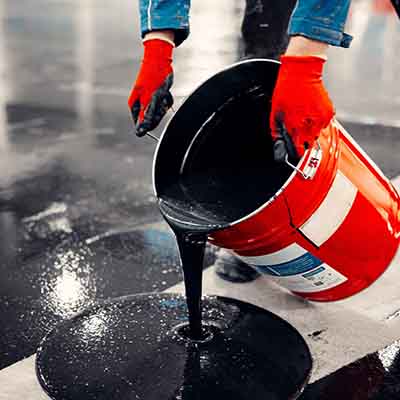
Flexible & Reinforced Bitumen Waterproof Coating
Bitumen waterproofing coating is a protective layer applied to various surfaces to prevent water ingress. This coating utilizes bitumen, a viscous, black, and sticky substance derived from crude oil. Bitumen’s inherent water-resistant properties make it an ideal material for creating barriers against moisture. This type of waterproofing is commonly used in construction for roofing, basements, and other structures prone to water exposure. Bitumen waterproofing coatings are essential for protecting buildings and infrastructure from water damage, which can lead to severe structural issues and costly repairs.
Importance and Relevance in Construction and Maintenance
In construction, ensuring structures remain dry is crucial to their longevity and stability. Water infiltration can lead to severe damage, including mold growth, structural weakening, and material degradation. Bitumen waterproofing coatings provide an effective solution, protecting buildings, roads, and bridges from water damage. By preventing water from penetrating the structure, these coatings help maintain the integrity of the materials used, ensuring that buildings and infrastructure remain safe and functional for longer periods. This makes bitumen waterproofing a vital component in both new construction and maintenance projects.
Composition of Bitumen Waterproofing Coating
Basic Components
Bitumen waterproofing coatings primarily consist of bitumen, a binding agent, and fillers. The bitumen acts as the core water-resistant element, while fillers and binders enhance the coating’s mechanical properties. The composition may vary depending on the specific type of bitumen waterproofing product and its intended application. In addition to the primary components, certain additives may be included to enhance specific properties, such as UV resistance, flexibility, and adhesion. The precise formulation of bitumen waterproofing coatings is carefully designed to provide optimal performance in a variety of conditions and applications.
Additives and Enhancements
Additives such as polymers (e.g., styrene-butadiene-styrene or SBS) are often included to improve flexibility and durability. These enhancements allow the coatings to withstand temperature fluctuations and mechanical stress better. Other common additives include antioxidants to prevent aging and degradation, plasticizers to increase flexibility, and fillers to improve strength and durability. The use of these additives ensures that bitumen waterproofing coatings can perform effectively under a wide range of environmental conditions and stresses, making them suitable for various construction and maintenance applications.
Environmental Considerations
While bitumen itself is a petroleum product, modern formulations aim to minimize environmental impact. Eco-friendly alternatives and recycling initiatives are becoming more prevalent, making bitumen waterproofing coatings a more sustainable choice. Manufacturers are increasingly using recycled materials and developing formulations that reduce the emission of volatile organic compounds (VOCs). Additionally, efforts are being made to improve the lifecycle of bitumen products, ensuring that they can be reused or safely disposed of at the end of their service life. These environmental considerations are essential in making bitumen waterproofing a more sustainable option for construction and maintenance projects.
Types of Bitumen Waterproofing Coatings
1. Liquid Applied Membranes
Definition and Characteristics
Liquid applied membranes are bitumen coatings applied in liquid form, which cure to form a seamless, flexible membrane. These membranes can easily conform to complex surfaces and provide robust waterproofing protection. Liquid applied membranes are known for their ability to create a continuous barrier without seams or joints, which can be potential points of failure in other types of waterproofing systems. They are particularly useful for applications on irregular or complex surfaces where traditional sheet membranes may not be practical.
Application Process
Application involves cleaning the surface, applying a primer, and then spreading the liquid bitumen evenly. It can be applied using brushes, rollers, or sprayers, making it suitable for various surface types. The process typically requires multiple coats to achieve the desired thickness and level of protection. Each layer must be allowed to cure before the next is applied, ensuring a strong, durable bond. The flexibility of the liquid application method allows it to be used in a wide range of applications, from small residential projects to large commercial or industrial installations.
Pros and Cons
Pros include ease of application, seamless coverage, and adaptability to different surfaces. Cons may include longer curing times and the need for multiple coats for optimal protection. Liquid applied membranes are also susceptible to weather conditions during application, which can affect the curing process and the final performance of the coating. However, their versatility and effectiveness make them a popular choice for many waterproofing applications.
2. Sheet Membranes
Definition and Characteristics
Sheet membranes are pre-fabricated bitumen sheets that are applied to surfaces to provide waterproofing. These sheets are typically reinforced with polyester or fiberglass for added strength. Sheet membranes offer consistent thickness and coverage, which can be an advantage in ensuring uniform protection. They are available in various sizes and thicknesses, making it possible to choose the right product for specific applications and requirements.
Application Process
The application involves cleaning and priming the surface, then laying down the sheet membrane and securing it with adhesives or mechanical fasteners. Overlapping the sheets ensures a continuous waterproof barrier. Proper installation is critical to the performance of sheet membranes, as gaps or improper overlaps can compromise the waterproofing effectiveness. The process may also include sealing the edges and joints to prevent water ingress.
Pros and Cons
Pros include quick installation, immediate waterproofing, and consistent thickness. Cons can be difficulty in applying to complex shapes and the need for careful handling to avoid seams and gaps. Sheet membranes may also require specialized equipment and skills for proper installation, which can increase the overall cost and complexity of the project. Despite these challenges, sheet membranes remain a reliable and widely used waterproofing solution.
3. Bituminous Paints
Definition and Characteristics
Bituminous paints are bitumen-based coatings that provide a protective layer against water and corrosion. They are often used on metal and concrete surfaces. Bituminous paints offer a simple and cost-effective solution for waterproofing and protecting surfaces from environmental damage. They are available in various formulations, including solvent-based and water-based options, to suit different applications and preferences.
Application Process
Application is straightforward, involving surface cleaning and direct application of the paint using brushes or sprayers. Multiple coats may be required for optimal protection. The ease of application makes bituminous paints a popular choice for DIY projects and smaller-scale applications. However, achieving the desired level of protection may require careful attention to the number of coats and the drying time between applications.
Pros and Cons
Pros include ease of application, corrosion resistance, and versatility. Cons include the potential for lower durability compared to other bitumen products and the need for regular maintenance. Bituminous paints may also have limitations in terms of their performance in extreme weather conditions or under heavy mechanical stress. Despite these limitations, they remain a valuable option for many waterproofing and protective applications.
4. Modified Bitumen Membranes
Definition and Characteristics
Modified bitumen membranes are enhanced with polymers to improve their performance. These membranes offer superior flexibility and resistance to extreme weather conditions. The addition of polymers, such as SBS or atactic polypropylene (APP), enhances the bitumen’s properties, making it more adaptable to temperature variations and mechanical stress. This makes modified bitumen membranes a reliable choice for a wide range of applications.
Application Process
The application process is similar to sheet membranes but may include additional steps like torching or cold adhesive methods to secure the membrane in place. Proper surface preparation and application techniques are essential to ensure the membrane’s performance and longevity. The use of specialized tools and equipment may be required, depending on the specific type of modified bitumen membrane being used.
Pros and Cons
Pros include enhanced durability, flexibility, and resistance to weathering. Cons include the need for specialized application techniques and higher costs compared to standard bitumen membranes. Modified bitumen membranes are particularly well-suited for applications where long-term performance and resistance to environmental conditions are critical. While they may require a higher initial investment, their superior properties often result in lower maintenance and repair costs over time.


